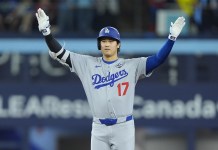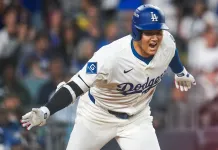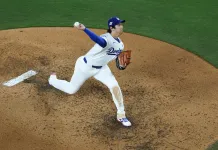The Tampa Bay Rays are one of the most incredible organizations in sports. Locked into a division with perennial payroll powerhouses in the Yankees and Red Sox, along with Blue Jays and Orioles teams that have carried big salaries in the past, the Rays have become a model for other franchises.
The Rays had four playoff appearances in six seasons from 2008-13 and are currently on a run of three straight postseasons. They’re also on a streak of four straight winning seasons in which their Opening Day payroll ranked 26th, 28th, 30th and 28th. Their payroll hasn’t ranked higher than 22nd since 2001. Even with a brain drain featuring front-office losses such as Andrew Friedman, Chaim Bloom and James Click, not to mention countless other assistants and analysts, the Rays have been stunningly consistent in a game that has an imbalanced financial system that punishes small-market teams.
This offseason was an easy one for the Rays, as they were already set up for success and had very little to do to get ready for another postseason push in 2022.
2022 VSiN MLB Betting Guide
Offense
On a team loaded with talent, one name stands out above the rest. Wander Franco made his MLB debut last season and posted a .288/.347/.463 slash line with a .348 wOBA in just 70 games and 308 plate appearances. Franco was worth 2.5 fWAR, which ranked in the top 100 for position players with at least 300 plate appearances. He did that in his age-20 season with no experience at the MLB level and no 2020 season to use for development.
The Rays rewarded Franco with an 11-year contract extension at an average annual value of $16.55 million. It was the largest contract ever for a player with less than one year of service time, but he looks like a bona fide star. Franco’s promotion pushed out Taylor Walls and Vidal Brujan, who are two other strong homegrown talents. The Rays have an embarrassment of riches in the middle infield and just have to find positions for the others, along with a fringe top-100 prospect in Xavier Edwards.
I refer to the Rays as chameleons because they adapt to different offensive environments. On the whole in 2021, the Rays were 10th in wOBA at .322, which doesn’t sound all that impressive, but Tropicana Field is a terrible hitters’ park. The fact they were 12th in home wOBA is a testament to how well they performed. The Rays had a 10.2% BB% at home, which ranked sixth, and helped offset a .416 SLG that ranked 15th.
On the road, the Rays ranked fourth in wOBA at .323. They only walked 8.7% of the time, which still ranked ninth but was far lower than at home. There is a home bias with balls and strikes that leads to higher walk rates across the board at home, but the Rays were simply a more aggressive team on the road. In parks where they could do more damage, they finished fourth in SLG at .440 and pulled the ball at a higher rate. Their offensive philosophy changes depending on where they are. They offset the home park factor by walking more, then get into attack mode on the road.
%%offer%%
The thing that makes the Rays’ offense so special is just about everybody can contribute. There are no major weaknesses in the lineup. Calling someone an average player in other sports feels like a negative remark, but not in baseball, where there are so many below-average players across the league. The metric wRC%plussign% , which is park and league adjusted, defines a league average hitter as having a value of 100. A 103 wRC%plussign% means that hitter is 3% above league average. A 97 wRC%plussign% means 3% below league average. Most good hitters will be 115 or higher and most bad hitters will be 90 or lower.
Of the Rays’ top 12 in plate appearances last season, only one hitter had a wRC%plussign% below 100, and that was Manuel Margot, who is known more for his glove than anything else. Brandon Lowe hit 39 home runs and walked more than 11% of the time to lead the team with a 137 wRC%plussign% . Randy Arozarena was a 20/20 guy with 20 homers and 20 steals and posted a 128 wRC%plussign% . Austin Meadows and Mike Zunino combined for 60 homers and were both above-average hitters. Zunino was also an elite defensive catcher. Every player up and down the lineup for the Rays was an offensive contributor and an average or above average one at that.
The Rays’ depth is incredible, and they’re likely to get more from Walls, Brujan and a full season of Franco, who is already the best player on the team and was first able to legally buy a beer on March 1. The Rays’ 857 runs scored last season was a franchise record, and the offense is showing no signs of slowing down.
Since we’re hitting on position players, the Rays were also fourth in defensive runs saved and seventh in the all-encompassing Def metric at FanGraphs (which measures defensive runs above average), so not only do they create a lot of runs, they also prevent a lot of runs.
Pitching
Here’s where it could get a little dicey for the Rays. Tyler Glasnow pointed to MLB’s cold-turkey crackdown on foreign substances as the reason why he needed Tommy John surgery in August. Top prospect Shane Baz, arguably the second-best pitching prospect in baseball, had arthroscopic elbow surgery during spring training. Brendan McKay underwent the very challenging thoracic outlet syndrome surgery, which doesn’t have nearly the same track record as Tommy John.
With Glasnow sidelined, Ryan Yarbrough, Shane McClanahan and Josh Fleming are the only returning Rays to throw more than 100 innings last season. The Rays incorporate a lot of openers and will look to piggyback starters because of their aversion to having a pitcher face a lineup for the third time, but depth is still an issue. The number of available arms is smaller than the past and the injuries in the rotation may put a lot of extra strain on a bullpen that gets a ton of work.
Yarbrough is coming off of his worst season with a 5.11 ERA and a 4.45 FIP, as his command evaded him and he had one of the lowest LOB% marks at 62.8%. He also faded fast in the second half, which makes me wonder if the workload of a full 2021 season after the shortened 2020 season caught up with him. He posted a 6.44 ERA and gave up 10 homers in 58.2 innings in the second half.
McClanahan got stronger in his first MLB season, as he posted a 3.43 ERA with a 3.31 FIP in 123.1 innings. The hard-throwing southpaw is the most promising pitcher in this rotation. Fleming will likely start again out of necessity, but Drew Rasmussen will also get some starts along with hard-thrower Luis Patino and two-time Cy Young Award winner Corey Kluber. Rasmussen was more effective as a starter than as a reliever, holding opposing batters to a .209 wOBA in 42 innings as a starter. The 22-year-old Patino did not have his minor league strikeout numbers carry over to the bigs, but he was a dominant prospect in the Padres organization before injuries set in.
Kluber threw a no-hitter last year for the Yankees en route to a 3.83 ERA with a 3.85 FIP in 80 innings. He only threw one inning in 2020 and 35.2 innings in 2019 after five straight 200-inning seasons with the Indians. At 36, Kluber has pitched more than 1,400 innings and may not have a lot left in the tank. If there’s gas to be found, though, the Rays can find it.
The Rays ranked fourth in ERA at 3.67 and fifth in FIP at 3.79 last season. The rotation was strong, but the team led the league in reliever fWAR and was third in ERA (3.24) and first in FIP (3.59). The Rays incorporate what I’ve seen called a bullpen clock, which means they have relievers throw from several different arm slots so it becomes very hard to pick up the ball.
Much like the lineup, virtually every reliever is useful. Of the Rays’ top 11 relievers in innings pitched, Yarbrough was the only one with an ERA over 4.00 (4.03). Three relievers had an ERA under 2.00 and seven had an ERA under 3.00. The bullpen should be elite again, and the Rays have an uncanny ability to play “next man up” with relievers, whether they come from below or are acquired. Unfortunately, there was one big loss in spring training with Pete Fairbanks out for several months due to a lat injury. He was in line for a lot of high-leverage appearances.
Player to Watch
SP Luis Patino: Patino worked 17.1 innings during the shortened season in 2020, then threw 106.2 innings across two levels in 2021. He has tremendous strikeout upside and reportedly added a second slider that is softer and sweepier than his current one. With all of the starting pitcher injuries for the Rays, Patino takes on greater importance this season, especially with an injury risk such as Kluber. Righties slashed an anemic .201/.243/.351 with a .256 wOBA against Patino, while lefties batted .274/.378/.452 with a .356 wOBA and 21 walks against 22 strikeouts. Patino also had noticeable home/road splits. At 22, Patino has a lot of development left and a big leap in his second year would be huge. His spin rates are well above average, and if his command catches up, he could be something special.
Season Outlook
The Rays have been disrespected in futures and win totals markets for a while. They’re lined well behind the Blue Jays and Yankees to win the World Series at %plussign% 1600, and their season win total looks low at 89.5. This team is every bit as good as the Jays and Yankees. The pitching injuries are a legitimate concern, but no team identifies talent and fills holes like the Rays. With an impeccable track record of winning trades and developing talent, the Rays have proven they can compete with the big boys at a much lower payroll. If we extrapolate the 2020 season out to 162 games, the Rays were on track for 108 wins. They hit 100 for the first time last year and won 96 in 2019. The AL East is much stronger now with the emergence of the Blue Jays, but that shouldn’t hold the Rays down. I’ll have a futures investment on them again, as I did in 2019.
Win Total Pick: Over 89.5
Rays 17-1 to Win the World Series





